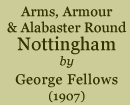< Radcliffe-on-Soar | Contents | Shelford >
His wife has a tight fitting bodice with a long plain robe caught aside from her waist by bows and rosettes, with sleeves puffed at the shoulders; her dress is not arranged in folds, as is so often seen in earlier monuments, but stands stiffly out from her feet, indicating the approaching fashion of wearing the farthingale, so much effected by ladies in Elizabethan times. Around the base of the tomb are a number of figures, chiefly female: if they represent their offspring they had a goodly family, for they number in the 'teens'; they are all slightly different in pose, several have a scroll behind their heads, and hold plain shields in front of them; one apparently is in grave clothes. There are no armorial bearings carved on this tomb.
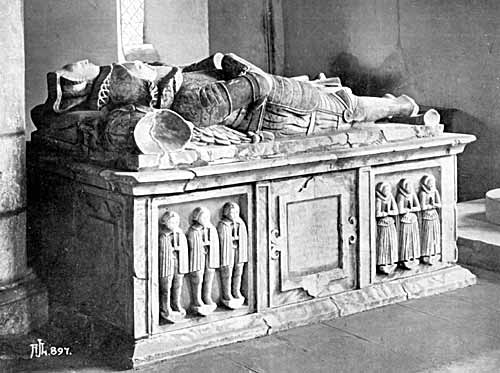 |
Tombs of Henry Sacheverell (1580), Radcliffe-on-Soar. |
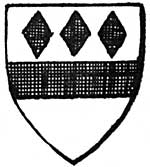 |
Under the next arch, eastward from the last-named, is yet another altar tomb to another Henry Sacheverell, together with his wife, Jane, daughter of German Ireton (spelt Irton on the tomb), of Ireton, co. Derby. He was the son of the foregoing Henry and Lucie. In the base of the tomb an incised slab is placed between the figures of his three sons and three daughters; the date of his death, however, is not filled in. He wears a pointed beard with a moustache, and is clothed in a massive breast-plate, with laminated cuisses over his slashed and quilted trunk hose; genouillieres at the knees, and greaves on the lower part of the leg. A ruff or frill round his neck and his feet, which are badly broken, rest upon his gauntlets ; his hands also are broken away. Traces of the paint originally used to embellish these effigies, especially the red, are still plainly to be seen. The lady is represented with her hair combed back off her forehead, and as having a sharp-pointed nose, which has so far escaped mutilation; a ruff round her neck, a delicately-carved ornament at the top of the bodice, and wearing a long dress, which stands stiffly out around her feet. At the west end of the tomb are two shields, showing the arms of Sacheverell on one, and on the other argent, a fesse sable, in chief three lozenges gules (or sable). On the east end of the tomb is a shield (which is now turned upside down!) bearing Sacheverell, impaling argent, a fesse sable, in chief three lozenges. Presumably these arms were meant for those of Ireton, but both in Burke's Armory and Lowe's Notts. Armory the Ireton arms are given as Ermine, two bends gules, and no doubt this is correct, for General Henry Ireton used such on his seal. This tomb stands on a brick plinth, and is of the same dimensions as the last-described: it was erected by their son, who gave £30 for a tomb to his father and mother, and willed £40 for a tomb for himself.— (Torre MS.)
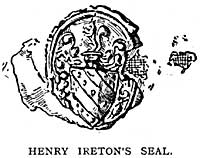 |
The last of this series of alabaster family tombs is that of another Henry Sacheverell, for the erection of which he willed, as already stated, £40, and it is placed against the south wall of the Chancel, consequently on the opposite side to the others. The Squire's effigy alone occupies the mensa, whilst above him, under a canopy, are the figures of his three wives, all kneeling facing eastward, with a small Prie Dieu, or book-rest, in front of each. Their costumes are interesting, as showing the slight changes of fashion that obtained during the early years of the first Stuart King. The centre panel of the tomb is occupied by the figures of three children in miniature presentment, the issue of his first marriage, so the inscription states, viz., one son and two daughters. Of these, two are represented in their chrisoms. As a matter of fact, the heir and one daughter died young, whilst the surviving daughter married Roger Columbell, as her first husband. The Manor of Radcliffe, which had been in the possession of the Sacheverells for 100 years or so, passed away to a nephew, Sir Thomas Hutchinson, by will of Henry Sacheverell, thus ignoring his sole daughter, who contracted an unfortunate second marriage; however, her cousin divided the Manor with her "out of tenderness." The Manor now belongs to Earl Howe.
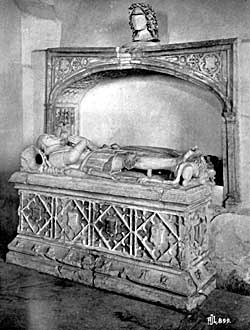 |
Tomb of Radulphus Sacheverell (1539), Radcliffe-on-Soar. |
On either side of the group of infants is a long inscription, which sets out the names of his respective wives and the date of his decease, viz., 17 Janvarie Ano. Dmi. 1625. He is represented in a heavy suit of armour, typical of his period, with taces, a ruff round his neck, narrow diagonal sword-belt, rere and vambraces, and his heels resting upon his gauntlets: he is shown with a moustache, beard, and long hair. Above the entablature is a shield bearing the family arms, surmounted by the crest, viz., a goat passant (although this is not the crest attributed to this branch of the family by Burke), and the motto, "En bon foy." On the east end are the arms of Sacheverell, impaling those of Boughton (his third wife's family), viz., argent, a chevron sable charged with three bucks' heads caboshed or. It is possible that the material for these tombs was procured on the spot, for the hills from which the village derives its name, Radcliffe, are full of gypsum.
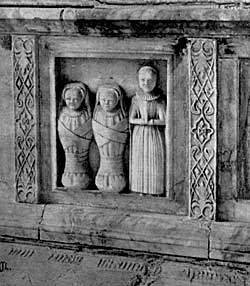 |
The children of Henry Sacheverell. |
< Radcliffe-on-Soar | Contents | Shelford >
